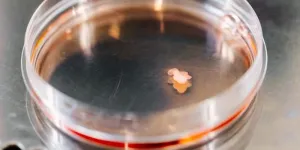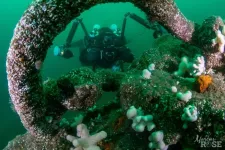(Press-News.org) An extremely energetic cosmic ray – an extragalactic particle with an energy exceeding ~240 exa-electron volts (EeV) – has been detected by the Telescope Array experiment’s surface detector, researchers report. However, according to the findings, its arrival direction shows no obvious source. Ultrahigh-energy cosmic rays (UHECRs) are subatomic charged particles from space with energies greater than 1 EeV – roughly a million times as high as the energy reached by human-made particle accelerators. Although low-energy cosmic rays primarily emanate from the sun, the origins of rarer UHECRs are thought to be related to the most energetic phenomena in the Universe, such as those involving black holes, gamma-ray bursts, and active galactic nuclei. Yet much about the physics and acceleration mechanisms of these particles remains unknown. Because arrivals of the most energetic UHECRs are so infrequent – estimated to be less than one particle per century per square kilometer – their detection requires instruments with large collecting areas. Here, members of the Telescope Array Collaboration report the detection of an extremely energetic cosmic ray observed by the Telescope Array (TA) experiment, a surface cosmic-ray detector array located in Utah, USA, that has an effective detection of 700 square kilometers. According to the findings, the unusually high-energy cosmic ray arrived on 27 May 2021 and had a calculated energy of about 244 EeV. Given the particle’s exceptionally high energy, the authors note that it should only experience relatively minor deflections by foreground magnetic fields, and thus, its arrival direction should be expected to be more closely correlated to its source. However, the findings show that its arrival direction shows no obvious source galaxy, or any other known astronomical objects thought to be potential sources of UHECRs. Instead, its arrival direction points back to void in the large-scale structure of the Universe – a region where very few galaxies reside. The authors suggest that this could indicate a much larger magnetic deflection than is predicted by galactic magnetic field models, an unidentified source in the local extragalactic neighborhood, or an incomplete understanding of the associated high-energy particle physics.
END
Extremely energetic cosmic ray detected, but with no obvious source
2023-11-23
ELSE PRESS RELEASES FROM THIS DATE:
Telescope Array detects second highest-energy cosmic ray ever
2023-11-23
In 1991, the University of Utah Fly’s Eye experiment detected the highest-energy cosmic ray ever observed. Later dubbed the Oh-My-God particle, the cosmic ray’s energy shocked astrophysicists. Nothing in our galaxy had the power to produce it, and the particle had more energy than was theoretically possible for cosmic rays traveling to Earth from other galaxies. Simply put, the particle should not exist.
The Telescope Array has since observed more than 30 ultra-high-energy cosmic rays, though none approaching the Oh-My-God-level energy. No observations have yet revealed ...
'Dolomite Problem': 200-year-old geology mystery resolved
2023-11-23
Images // Video
ANN ARBOR—For 200 years, scientists have failed to grow a common mineral in the laboratory under the conditions believed to have formed it naturally. Now, a team of researchers from the University of Michigan and Hokkaido University in Sapporo, Japan have finally pulled it off, thanks to a new theory developed from atomic simulations.
Their success resolves a long-standing geology mystery called the "Dolomite Problem." Dolomite—a key mineral in the Dolomite mountains in Italy, Niagara Falls, the White Cliffs of Dover and Utah's Hoodoos—is very abundant in rocks older than 100 million years, but nearly absent in younger ...
AI recognizes the tempo and stages of embryonic development
2023-11-23
Animal embryos go through a series of characteristic developmental stages on their journey from a fertilized egg cell to a functional organism. This biological process is largely genetically controlled and follows a similar pattern across different animal species. Yet, there are differences in the details – between individual species and even among embryos of the same species. For example, the tempo at which individual embryonic stages are passed through can vary. Such variations in embryonic development are considered an important driver of evolution, as they can lead to new characteristics, thus promoting evolutionary adaptations and biodiversity.
Studying the embryonic ...
Potential new target and drug candidate for Barth syndrome
2023-11-23
In a Nature Metabolism paper published today, researchers from the University of Pittsburgh detail a potential new target and a small-molecule drug candidate for treating Barth syndrome, a rare, life-threatening and currently incurable genetic disease with devastating consequences.
Barth syndrome affects about 1 in every 300,000 to 400,000 babies born worldwide. Those with the condition have weak muscles and hearts and experience debilitating fatigue and recurrent infections.
Pitt researchers discovered that faulty mitochondria are at least partially to blame, and identified a molecular culprit that could be targeted to potentially reverse the disease course in the future.
In ...
New therapy can treat rare and hereditary diseases
2023-11-23
A lot of research has been done over many decades on diseases that are widespread in large parts of the population, such as cancer and heart disease. As a result, treatment methods have improved enormously thanks to long-term research efforts on diseases that affect many people.
However, there are many diseases that affect just a handful people. These diseases often fly under the radar and are far less researched. They include quite a few rare, hereditary diseases, such as DOOR syndrome, which is ...
Y-chromosome and its impact on digestive diseases
2023-11-23
A major breakthrough in human genetics has been achieved with the complete decoding of the human Y chromosome, opening up new avenues for research into digestive diseases. This milestone, along with advancements in third-generation sequencing technologies, is poised to revolutionize our understanding of the genetic underpinnings of digestive disorders and pave the way for more personalized and effective treatment strategies.
The Y chromosome, the smallest of the human chromosomes, has long been shrouded in mystery due to its complex repetitive structure. However, recent advancements in sequencing technologies have enabled researchers to unravel the intricate details of this genetic ...
Fractional COVID-19 booster vaccines produce similar immune response as full-doses
2023-11-23
Reducing the dose of a widely used COVID-19 booster vaccine produces a similar immune response in adults to a full-dose with fewer side effects, according to a new study.
The research, led by Murdoch Children's Research Institute (MCRI) and the National Centre for Communicable Diseases in Mongolia, found that a half dose of a Pfizer COVID-19 booster vaccine elicited a non-inferior immune response to a full dose in Mongolian adults who previously had AstraZeneca or Sinopharm COVID-19 shots. But it found half-dose boosting may be less effective in adults primed with the Sputnik V COVID-19 vaccine.
The research ...
Consolidator Grants: ERC unleashes €627 million in grants to fuel excellent research across Europe
2023-11-23
Iliana Ivanova, European Commissioner for Innovation, Research, Culture, Education and Youth, said: “I extend my heartfelt congratulations to all the brilliant researchers who have been selected for ERC Consolidator Grants. I'm especially thrilled to note the significant increase in the representation of women among the winners for the third consecutive year in this prestigious grant competition. This positive trend not only reflects the outstanding contributions of women researchers but also highlights the strides we are making towards a more inclusive and diverse scientific community.”
President of the European Research Council Prof. Maria Leptin said: “The new ...
A fifth higher: Tropical cyclones substantially raise the Social Cost of Carbon
2023-11-23
Extreme events like tropical cyclones have immediate impacts, but also long-term implications for societies. A new study published in the journal Nature Communications now finds: Accounting for the long-term impacts of these storms raises the global Social Cost of Carbon by more than 20 percent, compared to the estimates currently used for policy evaluations. This increase is mainly driven by the projected rise of tropical-cyclone damages to the major economies of India, USA, China, Taiwan, and Japan under global warming.
“Intense tropical cyclones have the power to slow down the economic development of a country for more than a decade, our analysis shows. With global warming, the share ...
Study reveals how shipwrecks are providing a refuge for marine life
2023-11-23
An estimated 50,000 shipwrecks can be found around the UK’s coastline and have been acting as a hidden refuge for fish, corals and other marine species in areas still open to destructive bottom towed fishing, a new study has shown.
Many of these wrecks have been lying on the seabed for well over a century, and have served as a deterrent to fishers who use bottom towed trawling to secure their catches.
As a result, while many areas of the seabed have been damaged significantly in areas of heavy fishing pressure, the ...


